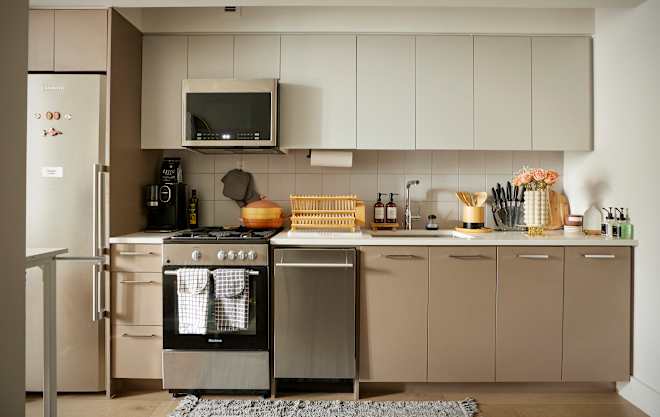I Tested 10 Splatter Screens to See Which Could Keep My Stove and Counters Clean
Splatter screens protect your stovetop and counters from sputtering grease and bubbling sauces. We tested 10 of them to find the four best ones.


I didn’t know what splatter screens were until I saw a host on The Cooking Channel use one while making eggplant Parmesan. They were frying the eggplant and didn’t want to get grease everywhere, so they slapped a splatter screen over the pan. I was a burly, rough-and-tumble chef back then, and I scoffed at someone who wanted to cook but not mess up their kitchen. In my mind, if you weren’t willing to make a mess, you weren’t really cooking.
But now that I cook at home almost every night, I realize how much easier cleaning a mess in a commercial kitchen is than doing the same in your own house. The default design of restaurant kitchens makes them easy to clean—you can slop soapy water everywhere, wipe things down, and mop the industrial floor. Home kitchens require a higher level of delicacy if you don’t want to clean up after cleaning up.
To find the best splatter screens, I took 10 top-rated models into my kitchen and put them through a series of tests, including frying, sautéing, and keeping sputtering red sauce at bay.
The Winners, at a Glance
The All-Clad splatter screen has reinforced edges for strength and longevity. It controlled grease droplets quite well and was one of the best at containing errant tomato sauce splatters.
The Le Creuset screen is on par with the All-Clad and features a silicone ring to better seal with your pan’s edge and control splatter. It performed better with oil than with tomato sauce but still ranked high among its competitors.
This features a flat silicone design that better accommodates multiple pan sizes than steel mesh screens. It controlled grease and almost wholly contained red sauce.
The BergKoch screen performed above average at a very affordable price. If you want a splatter screen but don't want to spend a lot, this is what I recommend.
The Tests

- Tomato Sauce Test: I heated jarred tomato sauce in a pan and let it simmer for 15 minutes. As tomato sauce heats, it frequently launches blobs of sauce. When I turned the burner on, I covered the pan with a splatter screen and observed if any molten sauce escaped—hitting the stove, hood, counter, cabinets, or floor (or myself). After 15 minutes, I grabbed the splatter screen by its handle (if it had one) and held it for 10 seconds to see if it stayed cool. Then, I hand-washed the screen and cleaned any errant sauce up to avoid mistaken results before moving on to the next screen and repeating this test.
- Fried Egg Test: I wanted to see how the splatter screens controlled popping oil. So, I fried an egg in a nonstick skillet, covering it with the screen. While the egg and oil sputtered and popped, I observed if any oil escaped and checked all nearby surfaces.
- Chicken Piccata Test: I shallow-fried chicken piccata in a cast iron skillet for the final test. I heated the pan and oil to 375°F (checked with an infrared thermometer) and added a breaded chicken cutlet, immediately covering the pan with a splatter screen. Again, I looked for errant oil pops that made it through the screen before flipping the chicken. I subsequently held the handle to check for heat and hand-washed the screen. I repeated my paper towel oil forensics and degreasing between tests.
What We Learned
Use an Appropriately Sized Pan

The tomato sauce test gave me some initial challenges because I tried to use an 8.5-inch saucepan with an ergonomically curved handle. I couldn’t get the screens to balance on the smaller saucepan; it was even a struggle with the All-Clad, which had cutouts in the rim to fit around handles.
But when I tested them with a 10.5-inch nonstick skillet, all of the screens (except the Frywall) fit flush against the lip of the pan. There was some variation in screen diameters, but, for the most part, the size difference wasn’t big enough to be noticeable.
Most Splatter Screens Were Built the Same

With a couple of exceptions, all the splatter screens I tested were variations on the same design. Setting the two outliers aside, each screen had a circular frame with wire mesh or perforated metal spanning the frame’s diameter. The handles were either bare stainless steel or silicone-coated stainless. Two models, from Le Creuset and OXO, had folding handles, which I found helpful for storage.
Now for the outliers: The silicone splatter screen from Williams Sonoma was still technically a circle with mesh that sat on top of a pan, but the mesh was silicone with large perforations, and the screen lacked a handle. The Frywall was a conical band of silicone that fit inside the pan rather than resting on top. I recommend the former but not the latter, but I'll get into why soon.
No Screen Prevented All Splatter

What these screens do is minimize splatter, but they don’t keep them from happening. I tested an array of mesh sizes from fine to large, and I can't say fine mesh prevented grease splatters better than large mesh. There was a film of grease on my counter after making chicken piccata with all the screens. Likewise, there were tomato sauce splatters. But I know what my stovetop and counters look like when I cook without one, and cleanup was much easier after using any of these screens.
The Criteria: What to Look for in a Splatter Screen

A splatter screen should significantly reduce splatter and sit flush with cookware. Most of the splatter screens performed well in my tests and what you should focus on are the size, handle type, and price. The largest screen I tested measured 21.5 inches, including the handle. Storing something of that size can be challenging, even if you hang it on a wall or rack. To that end, some screens had folding handles that helped minimize storage needs. Did the $9 BergKoch perform as well as the $72 All-Clad, and can you expect similar longevity from the two? No, but the BergKoch held its own, and you might get a few years out of it. In that sense, the best splatter screen also depends on how much you want to spend.
Our Favorite Splatter Screens
What we liked: The All-Clad was the most expensive of the lot, but it also had some cool features that expanded its usefulness and longevity. First, it had a 1.5-inch stainless steel rim around the screen, which provided extra strength and helped prevent tearing. A half-inch lip descends from the screen’s outer edge, with cutouts for pan handles that allow the screen to sit flush against the pan’s rim. It did the best job overall of containing splatters and messes out of all the screens I tested.
What we didn’t like: Well, it's certainly expensive (about 20% more than its closest competitor). I can’t argue with the design or the performance, but this is a splatter screen designed for people who want to make an investment.
Key Specs
- Screen diameter: 13 inches
- Handle length: 7.5 inches
- Material(s): Stainless steel
- Mesh size: Fine
- Dishwasher-safe: Yes
What we liked: Like the All-Clad, this splatter screen is highly engineered and made of quality materials. It has a 1.5-inch stainless steel rim for reinforcement and a silicone band around the bottom edge to improve its seal with cookware, reducing wayward splatters. Its angled, 8.5-inch handle provided an ergonomic grip and folded flat against the screen for easier storage. It performed best in the oily tests, with no splatters when cooking eggs and only the finest film of oil on the stovetop after frying chicken.
What we didn’t like: It eventually let a small amount of tomato sauce splatter onto the stovetop near the 10-minute mark.
Key Specs
- Screen diameter: 12.75 inches
- Handle length: 8.5 inches
- Material(s): Stainless steel, silicone
- Mesh size: Fine
- Dishwasher-safe: Yes
What we liked: This splatter screen plays off of the traditional design—it’s round and has a mesh of sorts. The perforated silicone has reinforced edges and is hinged in the center, allowing you to fold it for easy storage. One of the benefits of having no handle is that the screen sits flush on smaller pans without any wobbling.
What we didn’t like: There was no handle, and the silicone in contact with the pan got hot. The holes were wide and allowed some tomato sauce to burble through. Each of the holes has a raised, flared tip on either side of the screen, and those raised knobs made it difficult to clean.
Key Specs
- Screen diameter: 13.5 inches
- Handle length: No handle
- Material(s): Silicone
- Hole size: Large
- Dishwasher-safe: Yes
What we liked: Price doesn’t always equal performance. At first glance, I looked at the BergKoch and thought, “Oh, you don’t stand a chance, you poor thing.” While a couple of splatter screens that didn’t make my winners list rated slightly higher, it was by a fraction of a point, and the BergKoch was lower in price. It contained grease very well, with no apparent residue on the stove. The silicone-coated handle stayed cool, too, and it was easy to clean.
What we didn’t like: This screen didn’t perform as well in the tomato sauce test. I got some splatter on my stove and cabinets, but I can forgive this given the BergKoch's otherwise performance and its price.
Key Specs
- Screen diameter: 15 inches
- Handle length: 6.5 inches
- Material(s): Stainless steel, silicone
- Mesh size: Fine
- Dishwasher-safe: Yes
The Competition
Also Recommended
- OXO Good Grips Stainless Steel Splatter Screen: This splatter screen has a cool design, with ridges that ostensibly accommodate smaller-diameter pans, allowing the screen to sit flush. The medium mesh was a little abrasive—like a really dull cheese grater—and took chunks out of my sponge when I washed it. It did a good job of containing splatters but picking little blue pieces of cellulose out of the mesh after washing took it out of the running for me. That said, associate editorial director Riddley Gemperlein-Schirm has owned this screen for years and says it's held up.
- U.S. Kitchen Supply 13 Inch Stainless Steel Fine Mesh Splatter Screen: I have nothing negative to say about this splatter screen. It was fine; it just didn’t stand out.
Not Recommended
- Lodge 13-Inch Splatter Screen: This splatter screen didn’t make the list because of a weight problem. I had a hard time balancing the screen on a 10.5-inch skillet because the 7.5-inch handle threw it off. There was a gap between the pan and screen opposite the screen’s handle that let grease escape and accumulate on my stovetop.
- Frywall 12: The Frywall isn’t a splatter screen per se. It’s a silicone cone that sits around the interior edges of the pan’s bottom and provides a “wall” to contain grease and splatters. It’s much like a “cone of shame” one puts on their pet to keep them from picking at wounds. I fought with this thing from the get-go. It was a floppy silicone ring that wouldn’t stay upright without some prodding and heat application. I could use it in just two of the tests because it only fits pans with a 12-inch internal diameter (that’s on me, not them), and molten blobs of tomato sauce shot up and over the top, hitting my hood, cabinets, stove, foot, and floor.
- KitchenAid Gourmet Odor Absorbing Splatter Screen: The KitchenAid splatter screen did well in the first two tests but warped when I set it on the cast iron pan for the chicken piccata test, which provided an easy exit for grease.
- HIC Kitchen Splatter Screen: This is a perfectly adequate screen for the price, but I found a fine oily mist on my stovetop after the egg and piccata tests. It also eventually allowed some tomato sauce to escape and accumulate on the stove.
FAQs
Can you put a splatter screen in the dishwasher?
Every splatter screen I tested was dishwasher-safe. Check your manufacturer’s care suggestions before assuming your splatter screen is, though.
How do you clean a splatter screen?
Splatter screens are easy to clean, but given the tasks we subject them to, they might require extra care. The first, most obvious method for cleaning them is to put them in the dishwasher, provided your screen is dishwasher-safe. But in the tomatoey, oily environments I subjected the splatter screens to, hand-washing was a necessary first step. Grease or tomato sauce can accumulate around the edges where the screen meets solid material, where the handle meets the screen, and for those with hinged handles, in or under the hinges. Scrubbing these areas with hot, soapy water is always a good idea to extend your splatter screen’s lifespan,
How do you use a splatter screen?
Splatter screens are great for containing bubbly sauces or popping oil and couldn’t be simpler to use. Just place the screen on top of your pot or pan while cooking. Remove it to stir, turn, or flip food, and replace the screen until cooking's done.
Why We’re the Experts
- Greg Baker is a multi-time James Beard Award-nominated former chef from Tampa, Florida.
- He’s reviewed electric knives, coolers, non-alcoholic beer, and more for Serious Eats.
- Greg purposely got to cook sloppily for this piece while testing 10 splatter screens.
































































-Baldur’s-Gate-3-The-Final-Patch---An-Animated-Short-00-03-43.png?width=1920&height=1920&fit=bounds&quality=70&format=jpg&auto=webp#)

































































































































































































